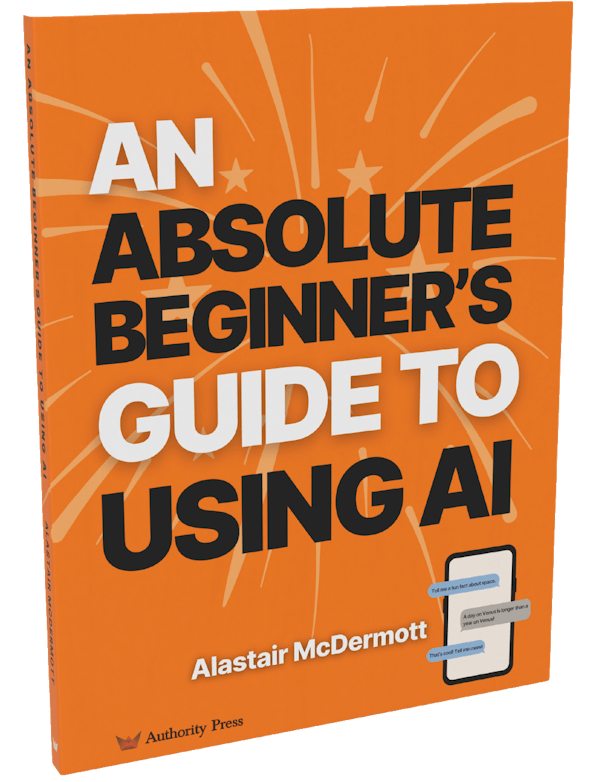I’ve built a lot of custom AI assistants using OpenAI’s CustomGPTs and other systems like Claude and Gemini over the past 12-18 months. However, this latest one is a little bit different. It’s a CustomGPT that helps you build effective custom AI assistants (“CustomGPTs”).
Introducing the Custom GPT Builder Assistant – Your AI Design Guide
The problem is building your own custom GPT can be overwhelming, and if you’re not techie it can be hard to create something that actually does what you intended. But it doesn’t have to be so difficult – if we use AI to help. Whether you need an AI assistant for customer support, content creation, or automating tasks, the key is having a structured plan.
That’s where my new Custom GPT Builder Assistant comes in. It doesn’t just give you tips – it guides you step by step through the entire process, asking the right questions and helping you refine your AI concept as you go.
You don’t need coding skills or technical expertise. Just start a conversation, and the assistant will help you turn your idea into a clear, structured GPT blueprint.
Table of Contents
How It Works: A Guided Process
Step 1: Start the Conversation
Simply type your idea into the assistant. You don’t need to know exactly what you want – the GPT will help you figure it out.
➡️ Best Practice: If you have a rough idea of what your AI should do, great! If not, no problem – the assistant will help clarify your vision.
Step 2: Define Your GPT’s Purpose
The assistant will ask:
“What’s the main goal of your GPT?”
It will help you decide between:
🔹 A single-purpose GPT – Focused on one task (e.g., writing social media captions).
🔹 A modular GPT – Combining multiple tools (e.g., a marketing AI suite).
➡️ Example: “I want a GPT that generates three variations of a product launch post for different platforms.”
After you answer, the assistant summarises your goal and asks if it sounds right before moving on.
Step 3: Identify Your Target Users
Next, the assistant helps define who will use your AI and what problems it solves. It will ask:
“Who is your target audience, and what challenges do they face?”
🔹 Are they business owners, marketers, students, or customer service teams?
🔹 What level of expertise do they have?
🔹 What problems does your GPT solve for them?
➡️ Example: “My users are small business owners who struggle with GDPR compliance. They need a simple AI to generate essential documents.”
Again, the assistant summarises your response for confirmation before continuing.
Step 4: Define Core Features
Now, you’ll decide what your GPT actually does. The assistant will ask:
“What key tasks should your GPT perform?”
🔹 Guide Users: Provide step-by-step instructions.
🔹 Automate Tasks: Reduce manual work like data entry.
🔹 Generate Content: Write blog posts, social media captions, or summaries.
🔹 Provide Expert Advice: Answer industry-specific questions.
➡️ Example: “My AI will guide users through GDPR compliance steps and generate required documents.”
Each answer you give is refined with AI-generated suggestions until you’re satisfied.
Step 5: Choose a Category
The assistant will help classify your GPT, asking:
“Which category best fits your GPT?”
🔹 Internal tool – Used within a company.
🔹 Public-facing GPT – Available for general users.
🔹 Personal assistant – Helps individuals with tasks.
🔹 Industry-specific tool – Tailored for a niche market.
➡️ Example: “My AI is a domain-specific tool for GDPR compliance.”
Once confirmed, the assistant moves on to finalising your blueprint.
Your Custom GPT Blueprint: The Final Output
At the end of the process, the assistant generates a structured document with:
✔️ Suggested Name – A user-friendly name for your GPT.
✔️ Description – A concise summary of what your GPT does.
✔️ Core Instructions – The logic and workflow behind your AI.
✔️ Data & Knowledge Requirements – What inputs your AI needs to function properly.
This document becomes your step-by-step guide to building your GPT.
Why This Process Works
🔹 It’s interactive – You don’t have to figure it all out alone. The assistant helps shape your idea.
🔹 It ensures clarity – Each step is reviewed before moving forward, so nothing gets lost.
🔹 It’s structured but flexible – You can refine answers and explore different options as you go.
🔹 It removes guesswork – By the end, you have a complete plan, ready for implementation.
Ready to Build Your Own Custom GPT?
If you’ve been wanting to create a custom GPT but weren’t sure where to start, this is your solution. The Custom GPT Builder Assistant makes the process simple, structured, and tailored to your needs.
💡 Try it now and see how easy it is to turn your AI idea into reality.
👉 What kind of GPT would you create? Let me know here on LinkedIn!








